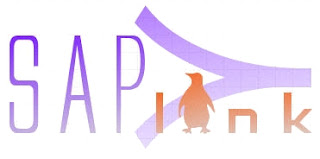Every information system needs to interact with the user in some way. Basic term
GUI (or frontend) stands for
Graphical User Interface and its common function is allow user to connect to the system and show /process user interaction (e.g. user’s inputs) with graphics in addition to text information. Predecessor to graphics interface was text based interface – CLI (Command Line Interfaces). As an example you can imagine first computer terminals. Then mouse (or other pointing device) feature was added and finally developed to GUI.
SAP AG intended to have a user centered design of their software. Over the period SAP GUI followed improvements as their flagship ERP - software. As a first step there was an R/2 user interface based on terminal screens.

It had following features: only on screen menu, list of function keys, message area, lines to separate field groups, question mark indicated required field.

Next step was R/2 user interface with CUA interface. It provided menu and a clickable pushbutton bar with the most important function keys.

Early version of SAP R/3 like 1.0 had characteristic like: leadings dots for field labels, field length not indicated, menu bar, pushbutton bar at the bottom showing the most important function keys.
In version 1.1 it had added: Field length indicated by background colors, fast paths in menus (for keyboard access).
And there was an influence of SAP technologies like: dynpro (dynamic screen with tables and elements), steploop (processing of dynpro) and ABAP list technology (for interactive reporting).
Next version R/3 version 2.0 introduced following: featured of new Windows 3.1 and other supported platforms (OSF/Motif, OS/2 and Mac OS), Windows look and feel (some), no leading dots for field labels, 3D look for entry fields, system and application toolbar, icons in system toolbar.

Version 2.0 was followed by 2.1 with elements like: new graphical elements: checkboxes, radiobuttons, group boxes, push buttons on screen, new icon look, list colors, Windows GUI becomes “standard GUI”. This “Windows version” was dominating GUI for SAP. It really looked like a "real" Windows application nevertheless, it is still terminal simulation only.
Next generation of R/3 started with 3.0 versions here new elements came: table control (based on dynpro technology; replacement for the steploop), icons on buttons, application toolbar, and proportional font for field labels.

In 3.1: Windows95 look: flat buttons (customizable), tabstrip control (dynpro technology), ABAP List Viewer (ALV).
Next major release of R/3 was
4.0: To evade difficult navigation more and more information is put into tabstrips of screens in order to have minimum screens in transactions.

Followed by
4.5: MS
ActiveX components were used to build new controls: splitters, trees, text fields, HTML, etc., ALV became a grid control.Another principal release was
4.6: With this GUI got renewed design by
Frog Design company. Once upon a time there existed nice page at
Frog Design site where all new GUI elements had been introduces but now it is disappeared.

Main goal was to get rid of initial screens and to reduce the need for screen changes, screen with tree added to the left sidebar, s
ingle screen paradigm. In years of dotcom age there was ITS server introduces which translated SAP screens to HTML code and then sending them to user’s web browser. Development of ITS started with mySAP.com Workplace initiative.
In years of dotcom age there was ITS server introduces which translated SAP screens to HTML code and then sending them to user’s web browser. Development of ITS started with mySAP.com Workplace initiative.
Nowadays is the most poplar version of SAP GUI for WIN platform version
6.2 and
6.4. It matured into a universal client for accessing SAP functionality in SAP almost all applications such as:
mySAP ERP, mySAP Business Suite (mySAP CRM, mySAP SCM and mySAP PLM, …), and NetWeaver components like SAP BW. SAP GUI functions like a browser. It gets information from the SAP server like what, where, when and how, to display contents in its window.
SAP GUI family has there main branches:
- SAP GUI for WINDOWS environment – for MS WINDOWS platform, provides “Windows like” user experience, integration with other applications (MS Office, MS Outlook), based on OLE interfaces and/or ActiveX controls.
- SAP GUI for JAVA environment - unified SAP frontend for multiple platforms
- SAP GUI for HTML – by SAP ITS server SAP screens elements in transactions gets mapped to HTML using HTMLb (business HTML) functions.
Next release - 7.10 of SAP GUI for WIN will be released on 05th of February 2007. There will be integration to new version of MS Windows: Vista and joint SAP and MS developed tool called Duet (formerly Mendocino).
To have a complet overview of SAP's user interfaces where SAP count's following:
- Web Dynpro - provides the development and runtime environment for creating web applications. Web Dynpro development environment consists of a set of integrated tools supporting the following core functions: specifying dialog flows; designing and composing views, (for example, the graphical presentation of a page); modeling business data types and customizing all of these aspects.
- SAP GUI family (see above)
- mobile UI - Online technology, where a mobile device (mobile phones, PDAs, etc.) connected to a web server, based on technologies such as WAP, wireless LANs, Bluetooth, etc. The aim is to extend and extend SAP's WAS or ITS, with features to provide technology which extends SAP's WAS or ITS, with features that allow application developers to create and modify mobile applications.
In my some of my next article I do focus on alternative next generation of SAP GUI called Muse - build on SAP xApps, Duet, Interactive forms based on Adobe, SAP NW Portal, mobile and voice solutions.

Despite all the progress what GUI has gone I’m still wondering why the hell there is so strange light blue color in SAP GUI while connected to SAP NetWeaver systems, like on this picture :-)
For preparation of this article it is been used this article as a guide SAP OSS pages.















































